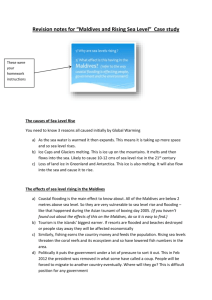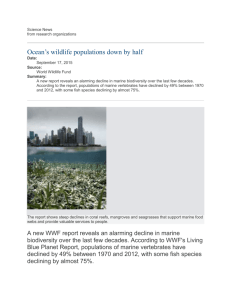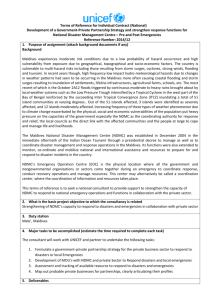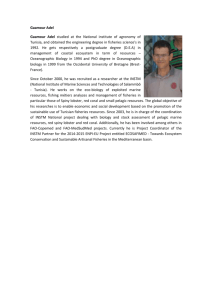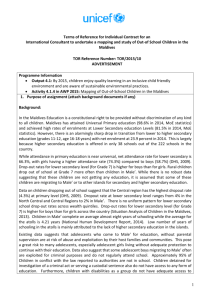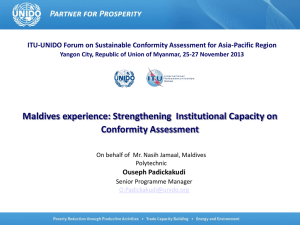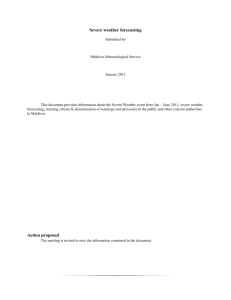Marine Maldives – medicine cabinet of the 21st century? According
advertisement
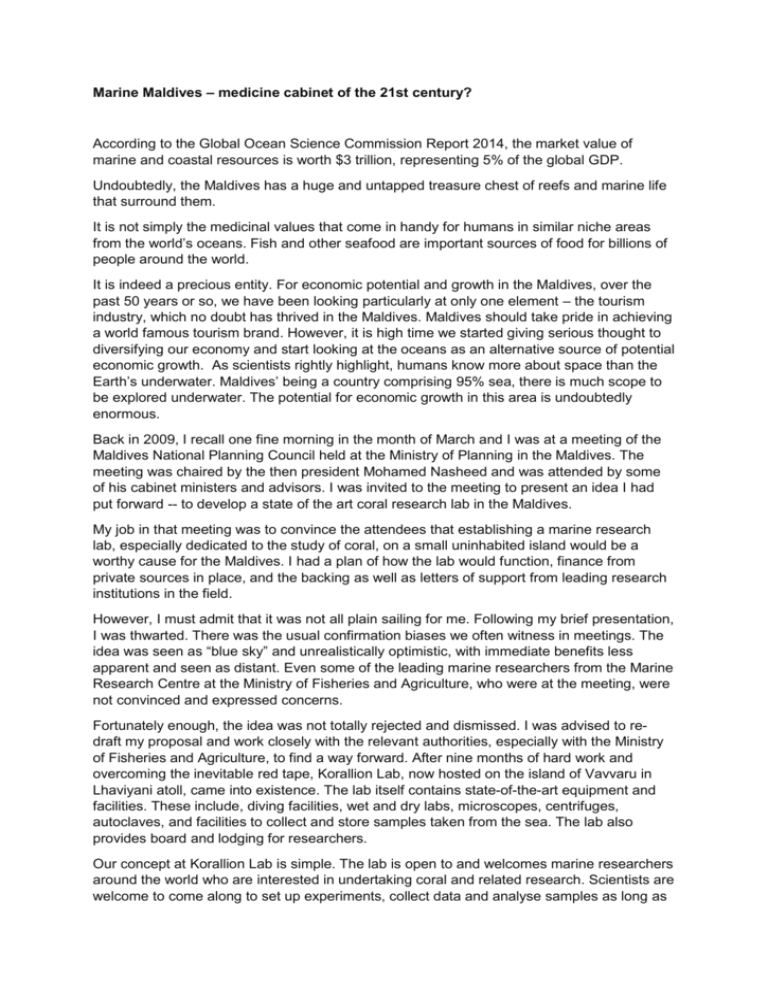
Marine Maldives – medicine cabinet of the 21st century? According to the Global Ocean Science Commission Report 2014, the market value of marine and coastal resources is worth $3 trillion, representing 5% of the global GDP. Undoubtedly, the Maldives has a huge and untapped treasure chest of reefs and marine life that surround them. It is not simply the medicinal values that come in handy for humans in similar niche areas from the world’s oceans. Fish and other seafood are important sources of food for billions of people around the world. It is indeed a precious entity. For economic potential and growth in the Maldives, over the past 50 years or so, we have been looking particularly at only one element – the tourism industry, which no doubt has thrived in the Maldives. Maldives should take pride in achieving a world famous tourism brand. However, it is high time we started giving serious thought to diversifying our economy and start looking at the oceans as an alternative source of potential economic growth. As scientists rightly highlight, humans know more about space than the Earth’s underwater. Maldives’ being a country comprising 95% sea, there is much scope to be explored underwater. The potential for economic growth in this area is undoubtedly enormous. Back in 2009, I recall one fine morning in the month of March and I was at a meeting of the Maldives National Planning Council held at the Ministry of Planning in the Maldives. The meeting was chaired by the then president Mohamed Nasheed and was attended by some of his cabinet ministers and advisors. I was invited to the meeting to present an idea I had put forward -- to develop a state of the art coral research lab in the Maldives. My job in that meeting was to convince the attendees that establishing a marine research lab, especially dedicated to the study of coral, on a small uninhabited island would be a worthy cause for the Maldives. I had a plan of how the lab would function, finance from private sources in place, and the backing as well as letters of support from leading research institutions in the field. However, I must admit that it was not all plain sailing for me. Following my brief presentation, I was thwarted. There was the usual confirmation biases we often witness in meetings. The idea was seen as “blue sky” and unrealistically optimistic, with immediate benefits less apparent and seen as distant. Even some of the leading marine researchers from the Marine Research Centre at the Ministry of Fisheries and Agriculture, who were at the meeting, were not convinced and expressed concerns. Fortunately enough, the idea was not totally rejected and dismissed. I was advised to redraft my proposal and work closely with the relevant authorities, especially with the Ministry of Fisheries and Agriculture, to find a way forward. After nine months of hard work and overcoming the inevitable red tape, Korallion Lab, now hosted on the island of Vavvaru in Lhaviyani atoll, came into existence. The lab itself contains state-of-the-art equipment and facilities. These include, diving facilities, wet and dry labs, microscopes, centrifuges, autoclaves, and facilities to collect and store samples taken from the sea. The lab also provides board and lodging for researchers. Our concept at Korallion Lab is simple. The lab is open to and welcomes marine researchers around the world who are interested in undertaking coral and related research. Scientists are welcome to come along to set up experiments, collect data and analyse samples as long as their projects are approved by the government of Maldives. With the help of international experts, we also run a number of training programmes in the form of summer and winter schools. The basic idea is to promote Maldives as a brand and as a destination for cuttingedge marine research and teaching. Korallion Lab – Vavvaru Island, Maldives On top of this, we run some important programmes for the locals. These include lectures to be given at local schools by foreign scientists who visit the lab, to allow students to observe research on the field conducted by experts, and provide them opportunities to actively participate in conducting research in the lab. The enthusiasm generated over a short time period among the youngsters, especially those living in the islands near the lab, has been tremendous. In fact, it was only last month I met a 10-year-old from the local Naifaru island who told me that he has been dreaming to visit Korallion Lab to learn more about coral. Later, I was thrilled to know that he and his classmates did visit the lab the following week. The story of Korallion lab is, of course, a simple example of such research, I believe. There are a number of similar programmes in the Maldives, primarily led by the Ministry of Fisheries and Agriculture. These include research into coral and reef fisheries such as breeding of grouper and reef fish, and mariculture activities such as breeding of sea cucumber, ornamental fish, pearl, and cultivation of sea weed. However, compared to the potential for economic growth that the coral reefs and the sea in general have to offer, the number of such programmes being run in the Maldives is negligible. Could these creatures one day give us a molecule that could be used as a perfect cure for cancer? In fact, what we have established thus far presumably signifies “just a drop in our oceans”. The world’s oceans are one of the least explored entities by scientists. With so little explored, the oceans offer so much potential for new discoveries including new medicines. In fact, the National Oceanic and Atmospheric Administration in the United States refers to the world's oceans, especially the coral reefs where we find most biodiversity, as the "medicine cabinets of the 21st century". Even today, more than half of modern pharmaceuticals are derived from the natural world. Thus, the reefs and the creatures that live on and around them reveal vast and significant potential for medicine. According to a recent Ocean Commission’s report, there are numerous chemicals and biological materials from marine organisms, currently in use or in development as medicines. These include 10 anti-cancer drugs, drugs that fight inflammation, fungus, tuberculosis, HIV, malaria and dengue. In fact, new compounds with medical potential could theoretically be found anywhere in the sea. For example, a molecule that could treat anthrax was recently found in underwater sediment off the coast of California. Hence, marine ecosystems are likely to represent an increasingly important source of medical treatments, nutritional supplements, pesticides, cosmetics, and other commercial products. Products with medicinal values from the ocean are without question one of the most promising new directions of marine research and development.

